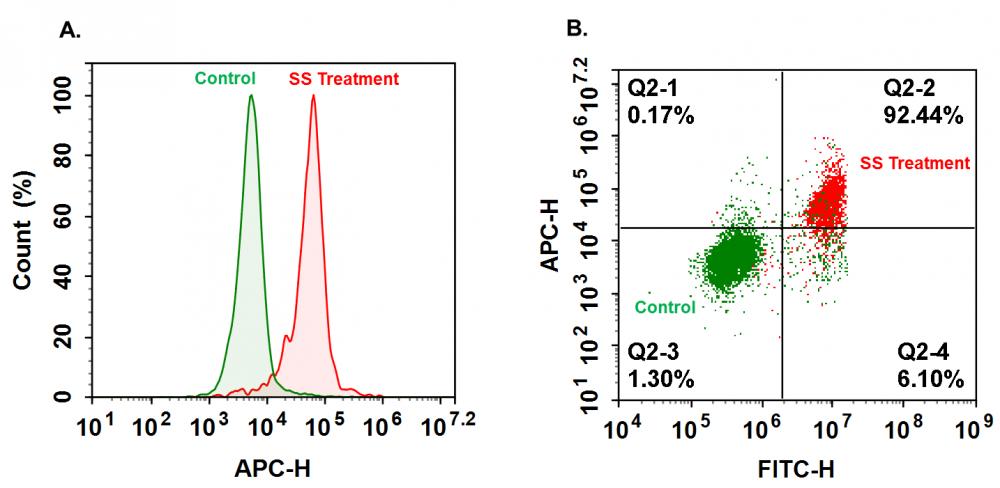上海金畔生物科技有限公司代理AAT Bioquest荧光染料全线产品,欢迎访问AAT Bioquest荧光染料官网了解更多信息。
Cell Meter 通用Caspase活性荧光法检测试剂盒 红色荧光 适合于流式细胞检测 价格 2823
产品规格
产品货号

| Ex (nm) | 649 | Em (nm) | 664 |
| 分子量 | – | 溶剂 | – |
| 存储条件 | – |
我们的Cell Meter 检测试剂盒是一套用于检测细胞生存力的工具。有多种参数可用于检测细胞活力。该特定试剂盒旨在通过测量活细胞中的通用胱天蛋白酶(胱天蛋白酶-1,-3,-4,-5,-6,-7,-8和-9)来检测细胞凋亡。胱天蛋白酶被广泛认为是细胞凋亡的可靠指标。大多数胱天蛋白酶具有对肽序列Val-Ala-Asp(VAD)的底物选择性。该试剂盒使用TF5-VAD-FMK作为大多数半胱天冬酶活性的荧光指示剂。 TF5-VAD-FMK是细胞可渗透的,并且与凋亡细胞中活化的casepase-1,-3,-4,-5,-6,-7,-8和-9不可逆地结合。一旦与胱天蛋白酶结合,红色荧光试剂将保留在细胞内。结合后阻止了胱天蛋白酶的进一步催化,但不会阻止凋亡的进行。添加到培养基中后的15分钟内,该试剂将开始与活性caspase酶反应。该试剂盒为所有必需成分提供了优化的测定方案。它用于定量凋亡细胞中大多数的胱天蛋白酶活性,或筛选胱天蛋白酶抑制剂。红色荧光标记允许通过流式细胞仪直接检测凋亡细胞中的胱天蛋白酶。金畔生物是AAT Bioquest的中国代理商,为您提供优质的Cell Meter 通用Caspase活性荧光法检测试剂盒。
点击查看光谱
适用仪器
| 流式细胞仪 | |
| Ex: | 640 nm |
| Em: | 660/20 nm |
| 通道: | APC 通道 |
样品实验方案
简要概述
- 用5×105至1×106细胞/ mL的密度制备含测试化合物的细胞
- 将0.5 µL细胞溶液中加入1 µL 500X TF5-VAD-FMK
- 将细胞在37°C,5%CO2培养箱中孵育1-4小时
- 沉淀细胞并将细胞重悬于0.5 mL检测缓冲液或生长培养基中
- 使用带有660/20 nm滤光片的流式细胞仪分析细胞(APC通道)
实验步骤
1.对于每个样品,在0.5mL温热培养基或自备缓冲液中以5×105至1×106cell/ mL的密度制备细胞。注意:应单独评估每种细胞系,以确定诱导凋亡的细胞密度。
2.用测试化合物处理细胞一段时间,以诱导细胞凋亡,并建立阳性和阴性对照。
3.向处理过的细胞中加入1µL 500X TF5-VAD-FMK(组分A)。
4.将细胞在37°C,5%CO2培养箱中孵育1-4小时。注意:对于贴壁细胞,用0.5 mM EDTA轻轻提起细胞以保持细胞完整,并在与TF5-VAD-FMK孵育之前用含血清的培养基洗涤细胞一次。合适的孵育时间取决于所用的单个细胞类型和细胞浓度。优化每个实验的孵育时间。
5.洗涤并旋转细胞两次。将细胞重悬于0.5 mL分析缓冲液(组分B)或生长培养基中。注意:TF5-VAD-FMK是荧光的;因此,重要的是洗净任何未结合的试剂以除去背景。
6.可选:用DNA染色剂标记细胞(例如绿色DCS标记死细胞,可以用530/30 nm滤光片(FITC通道)检测到。
7.可选:修复细胞。
8.使用带有660/20 nm滤光片(APC通道)的流式细胞仪检测荧光强度。
参考文献
Angiopoietins Modulate Survival, Migration, and the Components of the Ang-Tie2 Pathway of Chronic Lymphocytic Leukaemia (CLL) Cells In Vitro
Authors: Palma, Luis Mario Aguirre and Flamme, Hanna and Gerke, Iris and Kreuzer, Karl-Anton
Journal: Cancer Microenvironment (2016): 13–26
Hypoxia regulates TRAIL sensitivity of colorectal cancer cells through mitochondrial autophagy.
Authors: Knoll, Gertrud and Bittner, Sebastian and Kurz, Maria and Jantsch, Jonathan and Ehrenschwender, Martin
Journal: Oncotarget (2016)
Promotion of osteointegration under diabetic conditions by tantalum coating-based surface modification on 3-dimensional printed porous titanium implants
Authors: Wang, Lin and Hu, Xiaofan and Ma, Xiangyu and Ma, Zhensheng and Zhang, Yang and Lu, Yizhao and Li, Xiang and Lei, Wei and Feng, Yafei
Journal: Colloids and Surfaces B: Biointerfaces (2016): 440–452
Role of delta-like ligand-4 in chemoresistance against docetaxel in MCF-7 cells
Authors: Wang, Q and Shi, Y and Butler, HJ and Xue, J and Wang, G and Duan, P and Zheng, H
Journal: Human & Experimental Toxicology (2016): 0960327116650006
microRNA-186 inhibits cell proliferation and induces apoptosis in human esophageal squamous cell carcinoma by targeting SKP2
Authors: He, Wei and Feng, Jianfang and Zhang, Yan and Wang, Yuanyuan and Zang, Wenqiao and Zhao, Guoqiang
Journal: Laboratory Investigation (2016): 317–324
Glucose promotes cell proliferation, glucose uptake and invasion in endometrial cancer cells via AMPK/mTOR/S6 and MAPK signaling
Authors: Han, Jianjun and Zhang, Lu and Guo, Hui and Wysham, Weiya Z and Roque, Dario R and Willson, Adam K and Sheng, Xiugui and Zhou, Chunxiao and Bae-Jump, Victoria L
Journal: Gynecologic oncology (2015): 668–675
IL-7 abrogates the immunosuppressive function of human double-negative T cells by activating Akt/mTOR signaling
Authors: Allgäuer, Andrea and Schreiner, Elisabeth and Ferrazzi, Fulvia and Ekici, Arif B and Gerbitz, Armin and Mackensen, Andreas and Völkl, Simon
Journal: The Journal of Immunology (2015): 3139–3148
Insulin improves osteogenesis of titanium implants under diabetic conditions by inhibiting reactive oxygen species overproduction via the PI3K-Akt pathway
Authors: Wang, Lin and Zhao, Xiong and Wei, Bo-yuan and Liu, Yi and Ma, Xiang-yu and Wang, Jian and Cao, Peng-chong and Zhang, Yang and Yan, Ya-bo and Lei, Wei and others
Journal: Biochimie (2015): 85–93
LGL1 modulates proliferation, apoptosis, and migration of human fetal lung fibroblasts
Authors: Zhang, Hui and Sweezey, Neil B and Kaplan, Feige
Journal: American Journal of Physiology-Lung Cellular and Molecular Physiology (2015): L391–L402
t-BHQ Provides Protection against Lead Neurotoxicity via Nrf2/HO-1 Pathway
Authors: Ye, Fang and Li, Xiaoyi and Li, Lili and Yuan, Jing and Chen, Jun
Journal: Oxidative medicine and cellular longevity (2015)
